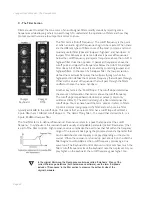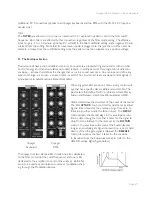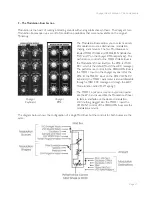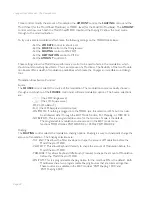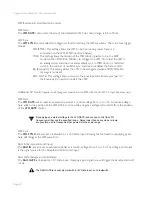
Page 24
Voyager User’s Manual - The Components
Page 25
Voyager User’s Manual - The Components
C – The Filter Section
Filters are used to adjust the tone color of an audio signal. Filters modify sounds by rejecting some
frequencies while allowing others to pass through. To understand the operation of filters and how they
process sound, there are a few important terms to know.
In the original Minimoog, the Resonance control was called ‘Emphasis’. Many of the
current Minimoog emulations (both hardware and software) use the term ‘Emphasis’
instead of ‘Resonance’ in the filter section to preserve the authentic vibe of the
original hardware.
Voyager
Keyboard
Voyager
RME
The first term is ‘Cutoff Frequency’. The cutoff frequency is the point
at which an audio signal’s frequencies begin to be rejected. Then there
are the different types of filters; some of the most common and most
musically useful filter types are ‘lowpass’, ‘highpass’, and ‘bandpass’. A
lowpass filter behaves as its name indicates; it passes all frequencies
below the cutoff frequency and rejects frequencies above the cutoff. A
highpass filter does the opposite. It passes all frequencies above the
cutoff point and rejects the frequencies below the cutoff. A bandpass
filter does a bit of both, since it is created by combining lowpass and
highpass filters. In the case of a bandpass filter, the lowpass section
defines the maximum frequency that will pass through, while the
highpass section defines the minimum frequency that will pass through.
What’s left is a band of frequencies that will pass through the filters
unaffected, hence the name, bandpass.
Another key term is the ‘Cutoff Slope’. The cutoff slope determines
the amount of attenuation that occurs above the cutoff frequency.
The cutoff slope is specified in decibels per octave (commonly
written as ‘dB/oct’). The electrical design of a filter determines the
cutoff slope. You may have heard the term ‘pole’ as it refers to filters.
A pole is simply a design aspect of a filter, and each pole in a filter
typically adds 6dB to the cutoff slope. This means that a one-pole filter has a cutoff slope of 6db/oct, a
2-pole filter has a 12dB/oct cutoff slope, etc. The classic Moog filter – the sound that started it all – is a
4-pole, 24dB/oct lowpass filter.
The final filter term to define is ‘Resonance’. Resonance refers to a peak that appears at the cutoff
frequency. In synthesizers, this resonant peak is usually an adjustable parameter (called ‘ Resonance’ ) that
is part of the filter controls. High resonance values emphasize the overtones that fall within the frequency
range of the resonant peak, givng the processed sound a character that
can be described as vocal, quacky or zappy, depending on the source
sound. When the resonance is turned up past about 8 on the dial, the
filter begins to self-oscillate at the cutoff frequency, producing a sine
wave tone. The Keyboard Control Amount control sets how much the
filters’ cutoff frequencies track the keyboard note that is played. As you
play higher on the keyboard, the cutoff frequency goes higher, too.















